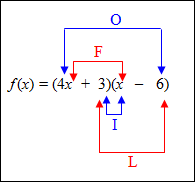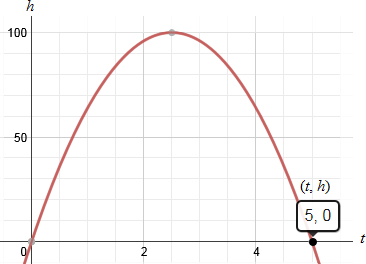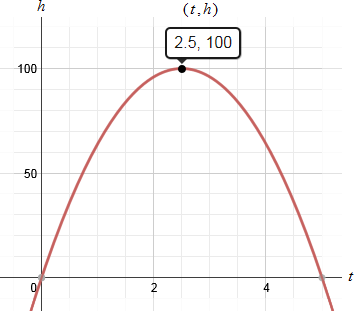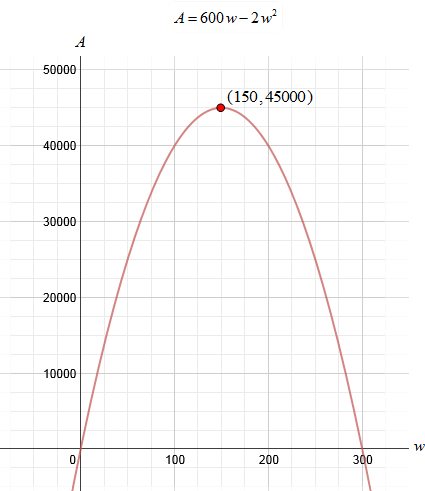QUADRATIC FUNCTIONS

Quadratic functions have important applications in science, engineering, and entertainment. For example, fireworks, when fired, follow a parabolic path and many explode when the vertex is reached. This unit will introduce you to quadratic functions. In addition, you will solve quadratic equations using factoring and the Zero Product Property. Lastly, you will explore many real-world applications of the quadratic functions and their parabolas.
Introduction to Quadratic Functions
Quadratic functions have the form f (x) = ax2 + bx + c where the highest exponent is 2.
Are the following functions, quadratic functions? |
| f (x) = 7x2 − 3x + 4 g (x) = 3x2 − 5 h (x) = 4x3 − 2x2+ x + 8 j (x) = 6x + 7 |
yes, the highest exponent is 2 |
parabola: the graph of a quadratic function
axis of symmetry: a line that divides the parabola into two parts that are mirror images of each other. vertex: either the lowest point on the graph or the highest point on the graph. domain of any quadratic function: the set of all real numbers. range: all real numbers ≥ the minimum value of the function (when opening up) or all real numbers ≤ the maximum value of the function (when opening down). If given a function, such as f (x) = (4x + 3)(x – 6), and asked to express it into quadratic form, use FOIL (First Outer Inner Last) multiplication to write it in the form y = ax2 + bx + c. |
Example #1: Express f (x) = (4x + 3)(x – 6) in quadratic form using the FOIL method.
Multiply the First terms, the Outer terms, the Inner terms, and the Last terms and add them.
Therefore, the quadratic form is y = 4x2–21x – 18. |
The general form for a quadratic function is y = ax2 + bx + c. Thus, a = 4, b = –21, and c = –18. |
By examining “a” in f (x) = ax2 + bx + c, it can be determined whether the function has a maximum value (opens up) or a minimum value (opens down).
 |
Example #2: Determine if vertex of the quadratic function is a minimum or a maximum point in its parabola and if the parabola opens upward or downward.
|
Let's practice:
![]() For the given function, state whether the parabola opens up or down and why.
For the given function, state whether the parabola opens up or down and why.
f (x) = –3x2 – 4x + 5
The parabola opens DOWN because "a" is negative (–3).
"Click here" to check the answer.
![]() Is the vertex of the parabola of this quadratic function a maximum or a minimum point?
Is the vertex of the parabola of this quadratic function a maximum or a minimum point?
f (x) = –3x2 – 4x + 5
Since the parabola opens downward, the vertex will be at a MAXIMUM point.
"Click here" to check the answer.
![]() For the given function, state whether the parabola opens up or down and why.
For the given function, state whether the parabola opens up or down and why.
(Hint: Put the equation in descending order first.)
f (x) = –3 + 2x + x2
The parabola opens UP because "a" is positive (1).
"Click here" to check the answer.
*Note: When there is no number in front of a variable, it is "understood" to be one.
Thus, in this last example, we think of x2 as 1x2.
![]() Is the vertex of the parabola of this quadratic function a maximum or a minimum point?
Is the vertex of the parabola of this quadratic function a maximum or a minimum point?
f (x) = –3 + 2x + x2
Since the parabola opens upward, the vertex will be at a MINIMUM point.
"Click here" to check the answer.
Solving Quadratic Equations by Graphing
One method that can be used for solving quadratic equations is graphing. The solutions of a quadratic equation are called the roots of the equation. The roots of a quadratic equation can be found by finding the x-intercepts or zeros of the quadratic function. A quadratic equation can have two real roots, one real root or no real roots. Real roots are numbers that are in the "real number system".
| roots of an equation: Roots are the solutions of a quadratic equation and can be called the zeros of the quadratic function. Two Real Roots |
Let's graph a quadratic that has TWO real roots as a solution.
| Example #1: Solve x2 − 6x + 8 = 0 First, write the equation as the related function: f (x) = x2 − 6x + 8. *Note: In the related function, just change zero to f (x). Next, graph the function.
Now, find the y-coordinate of the function by substituting 3 into the original function.
We now know the vertex of the parabola is (3, –1). Next, make a table of values, choosing x-values arbitrarily that give points on both sides of the vertex of the parabola. In the table of values for this function ,use x-values around x = 3, and substituting them into the original function to find the corresponding y-values; then graph each point.
From the table and the graph, the zeros (roots) of the function are clearly displayed. The zeros are 2 and 4. Therefore, the solutions of the equation are x = 2 and x = 4.
Now, let's examine the graph of a quadratic that has ONE real root as a solution.
|
No Real Roots |
Finally, let's examine the graph of a quadratic that has NO real roots.
| Example #3: Solve x2 − 4x + 5 = 0 by graphing. First, write the equation as the related function: f (x) = x2 − 4x + 5 Next, graph the function.
Now, find the y-coordinate of the function by substituting 2 into the original function.
We now know the vertex of the parabola is (2, 1).
The graph has no x-intercepts. This means that the equation has no real solutions. |
Estimate Roots |
Sometimes exact roots for a quadratic equation cannot be found. Instead, an estimate can be made by stating the consecutive integers between which the roots are located.
| Example #4: Solve −x2 + 4x − 1 = 0 by graphing. First, write the equation as the related function: f (x) = −x2 + 4x − 1. Next, graph the function.
Now, find the y-coordinate of the function by substituting 2 into the original function.
We now know the vertex of the parabola is (2, 3). Make a table of values for the function using x-values around x = 2 and substituting them into the original function to find the corresponding y-values; then graph each point.
The x-intercepts of the graph are between 0 and 1 and between 3 and 4. So, one solution is between 0 and 1, and the other is between 3 and 4. *Notice in the table that the value of the function changes from positive to negative between the x-values of 0 and 1 and between the x-values of 3 and 4. |
![]() The equation and its related graph are shown. What are the solutions (real roots) for the equation?
The equation and its related graph are shown. What are the solutions (real roots) for the equation? 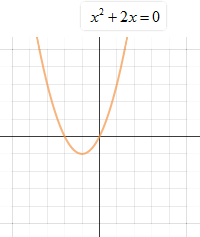
The solutions are x = 0 and x = –2.
"Click here" to check the answer.
![]() The equation and its related graph are shown. What are the solutions (real roots) for the equation?
The equation and its related graph are shown. What are the solutions (real roots) for the equation? 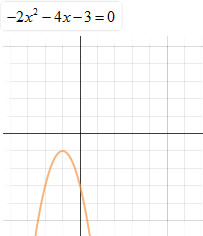
There are no real roots for this equation.
"Click here" to check the answer.
![]() The equation and its related graph are shown. What are the solutions (real roots) for the equation?
The equation and its related graph are shown. What are the solutions (real roots) for the equation? 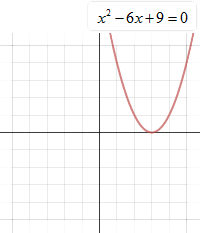
The solution is x = 3.
"Click here" to check the answer.
![]() The equation and its related graph are shown. What are the solutions (real roots) for the equation?
The equation and its related graph are shown. What are the solutions (real roots) for the equation? 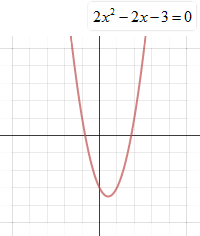
The solutions are between –1 and 0 and between 1 and 2.
"Click here" to check the answer.
Stop! Go to Questions #11-15 about this section, then return to continue on to the next section.
Solving Quadratic Equations
Quadratic equations that contain a perfect square can be solved by finding the square roots.
To solve quadratic equations using this method:
1.) isolate the quadratic term
2.) find the square root of each side
|
Stop! Go to Questions #16-19 about this section, then return to continue on to the next section.
Factoring Quadratic Expressions
Factoring reverses the process of multiplying two expressions.
A. Two terms
B. Three terms (leading coefficient = 1 or –1)
*If the leading coefficient is negative, factor out a –1 first, then proceed to find factors of the last term that add up to the middle term.
-look for a GCF
D. Three terms (leading coefficient > 1) Trial and Error
*The combination of (5x + 4)(x + 2) works because the product of the outside terms 10x and the product of the inside terms 4x will result in the middle term 14x. *If this had not worked, the 1 and 8 would have been used to try to determine a combination that gave the correct product sum. Again this is called Trial and Error, so there will be some cases where you would have to exhaust many possible combinations to find the correct combination. Be patient, this will get easier with practice. |
![]() Factoring Quadratic Equations (07:28)
Factoring Quadratic Equations (07:28)
The Zero Product Property
The Zero Product Property along with factoring is one method used to solve quadratic equations.
 |
To use the zero product property
1.) set the quadratic equal to zero
2.) factor the quadratic
3.) set each factor = to zero and solve
| Example #1: x2 + 4x − 32 = 0 (x + 8)(x − 4) = 0 x + 8 = 0 or x − 4 = 0 x = −8 or x = 4 The zeros or solutions to this quadratic are –8 and 4. Example #2: x2 = 11 x + 60 -set the quadratic equal to zero x2 = 11 x + 60 = 0 (x − 15)(x + 4) = 0 x − 15 = 0 or x + 4 = 0 x = 15 or x = −4 The zeros or solutions to this quadratic are 15 and –4. |
Stop! Go to Questions #26-30 about this section, then return to continue on to the next section.
Applications of Quadratic Functions
![]() Finding the Maximum Value of a Quadratic Function (02:12)
Finding the Maximum Value of a Quadratic Function (02:12)
Example #2: An arrow is shot upward with an initial speed of 112 feet per second. When will it reach a height of 160 feet? Use the equation h = 112t − 16t2. Solution: Since, we are given the equation and the height, we can find the time (t) by substituting 160 in for h in the equation and solving for t. Solution: Since, we are given the equation and the height, we can find the time (t) by substituting 160 in for h in the equation and solving for t.
Therefore, the arrow is 160 feet high both at 2 seconds (as it climbs) and at 5 seconds (as it falls) after being shot. |
Example #3: A farmer wants to enclose a rectangular region bordering on a river using 600 feet of fence. What is the maximum area the farmer can enclose? (No fence will be needed on the side along the river.)
Solution: Remember the formula for the perimeter of a rectangle is P = 2l + 2w.
Substitute 600 in for the perimeter, since the farmer has 600 feet of fencing.
Now, think of the width as w and solve the perimeter formula for length (l).
The formula for the area of a rectangle is Area = length × width.
Now we can find the formula for area to represent this situation.
We now have a quadratic equation A = 600w − 2w2 which has a parabolic graph. With quadratic equations, we can find a maximum vertex. This will help us find the maximum area when dealing with a rectangular area (three sides) that is contained with 600 feet of fencing. The vertex will be in the form (width, area); thus, we will find the width first (x‑coordinate of the vertex), and then use that number to find the maximum area possible (y-coordinate of the vertex). To find the vertex.
Therefore, the width of the rectangle of greatest area is 150 feet. To find the area, substitute w = 150 into the area formula.
The maximum area is 45,000 square feet.
|
![]() What is the length of the rectangular area fenced in on three sides
with 600 feet of
What is the length of the rectangular area fenced in on three sides
with 600 feet of
fencing that gives the maximum area?
l = 600 - 2w ... 600 - 2(150) = 300 feet
"Click here" to check the answer.
Stop! Go to Questions #31-34 to complete this unit.

